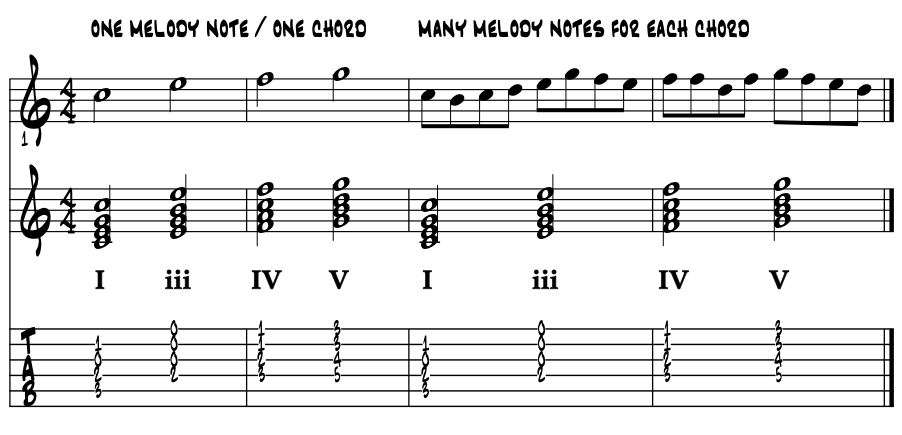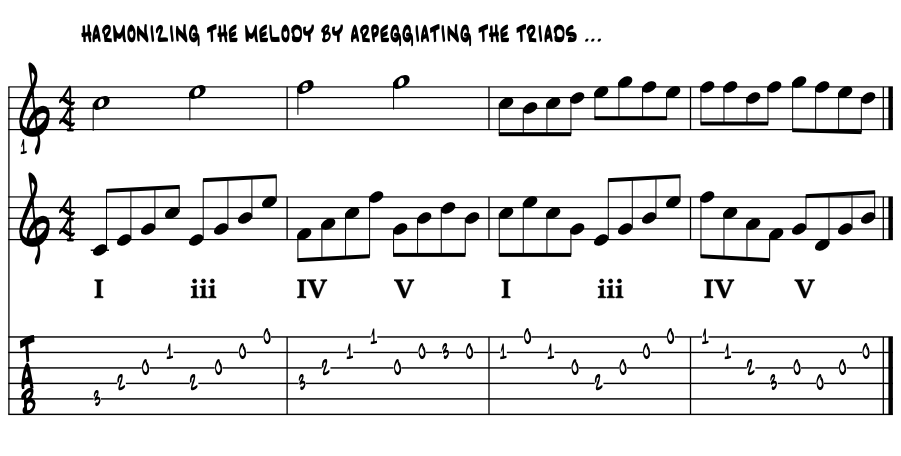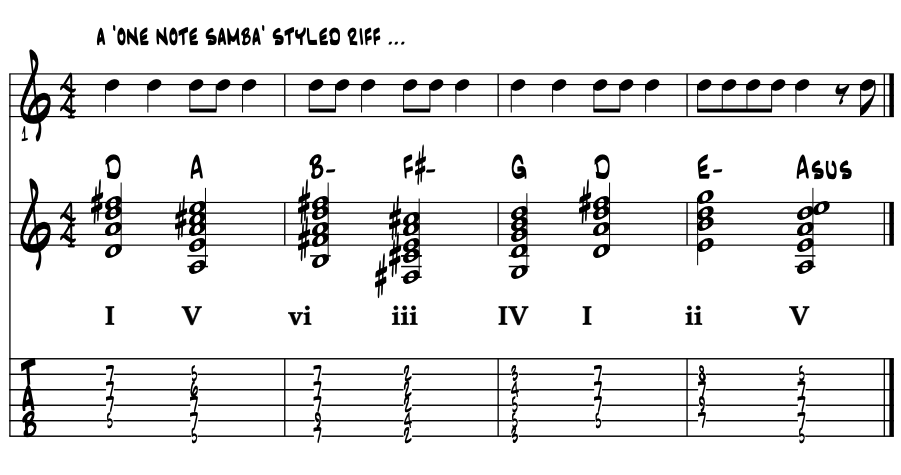|
In a nutshell ~ harmonization. Harmonizing a melody is simply about finding chords, those stacked up pitches all sounded together, to support a single or group of melody notes. So, one chord per melody note which we term a 'block' harmony. Or, one chord for many melody notes we can simply term 'much easier' :) In 'C' major, example 1. |
 |
Cool ? Click it again. Yea super common musical sounds and for good reason, as we hear this combo structure of melody and chords building songs on the radio all on through the bandwidth all the time. And while the style of music might change as we visit each new station along the way, the style of its writing, its composition, simply stays the same; a melody line supported by chords, the root pitches of which form a song's 'bass line story.' So much so that when we bump into music that's not created in this structure, of a 'melody note supported by a chord', our 'ear' hears something new and curiosity then may be engaged. In this next idea, we 'arpeggiate' the pitches of each of the block chords in support of the same melody line, giving us what we term a different 'texture' (and as it turns out older too) for the harmonization of the melody. Example 2. |
 |
Cool with arpeggios ... ? Always an easy way to 'sound out' any harmony, especially for horn players. In music theory terms, all three are versions of composing in the homophonic style, though the last two bars of arpeggios just above harkens us back to 'polyphony', from whence 'homophony' evolved. But having the melody note as the top note of a chord has for the last 300 years or so has totally fed the bulldog. For once the 12 pitches were tuned up all equal equal, and built into a key touch sensitive piano~forte, composers (mostly Euro) had a new unbreakable way to craft harmony support for their timeless melodies conjured from limitless imaginations. Hmm ... was there a piano on the Mayflower ... ? |
"Imagination is more important than knowledge." |
wiki ~ Albert Einstein |
Thus, all through our own Americana history with its myriads of evolutions; in styles and genres through our eras of modernization, from tonal to atonal in artistic statement, we're nine times out of 10 composing our songs in this often vertical looking, and yes potentially very very powerful chords / homophonic styled arrangements of the pitches. Cool so far ? |
fixx
In BA college studies. In my formal music school studies for the first four semesters, in the mornings we harmonized melodies and studied European harmony beginning with the music of J.S. Bach. This followed right along with music history classes. In the later semesters, as the history unfolds with new generations of composers, we used the Bach studies as the foundational basis to then explore the harmony of Haydn, Mozart, Beethoven and beyond. In the afternoons, we studied Americana jazz, which borrows all of the Euro harmony magics created by the Euro masters while infusing the dominant chord / V7 based blues through jazz literature; in form, blue note pitches, the Two / Five / One chord progression and dominant chord substitutions. Pepper in the diatonic chords in between and a lot of our gospel harmonies and chord progressions begin to manifest. And in the evenings at band practice we studied the evolutions of harmony / harmonization of melodies by John Coltrane. In this study. We then use this combined knowledge to explore and understand the harmonic complexities that are associated with now 100 years of our Americana jazz melodic / harmonic developments. Originally blues based, we combine the 'Americana jazz 'V7' with the 'Euro diatonic realm', and through an e-book's magical hyperlinks, create the Americana palette of harmony / chords for creating all of our styles and genres. |
Theory we may need to know. To get started with harmonizing melodies there's a few basics to be familiar with. Once under the fingers, the rest we can figure out as we work out more songs and melodies. Knowing these theory basics also become essential 'theory skills' that we can use in solving other challenges. Begin to rote learn the magics and once mastered you'll own them forever. Understand the idea of a song's diatonic 'key center.' The diatonic 'three and three' of popular music. Understand how the seven note diatonic scale becomes an arpeggio which spells its seven diatonic triads. Advancing harmonizing melody topics. Adding a 7th to each triad. The color tones. The concept of a 'chord type' and cadential motions. |
The flip side. In this next music example, we flip the process over by having one melody note that is rhythmically sustained through many chord changes to create a four bar phrase. Example 3. |
Cool ? Yea, we'll also occasionally hear this flipped combo of one melody note now supported by many chords all through our AmerAfroEuroLatin style weave of musics in creating our library of Americana songs. In music theory terms, even this 'flip side' we'd call 'writing in the homophonic style', which is the melody ~ chord pairing used to compose near all of our songs. Some history. For once the 12 pitches were tuned all equal equal, and built into a piano~forte of seven octaves, composers had a new and adaptable and even unbreakable way to craft harmony support for their timeless melodies, through all of the chord provided by our 12 paired, major / minor key centers. And in the improvisational nature of Americana musics, re-harmonizing melodies is a welcome challenge in creating something new, new aural art at every performance. Thus, all through our own 300 years or so of Americana history with it myriads of evolutions; in styles and genres, through our eras of modernization, we're nine times out of 10 composing our songs in this often very vertical looking, and yes potentially very very powerful chord / homophonic styled arrangements of the pitches. |
Review. This harmonizing of a melody could be the most important learning challenge we'll face in creating our art. For while we can often 'bolt up' a melody line into a form, the flip side to work out every nook and cranny of a complex melody (one that has lots of pitches) becomes for many an artist the 'fine art of' their own artistic signature. Then there's musical style. And can we harmonize the same melody different ways to bring it forth in different music style ... ? Sure. Why not ... ? And while rhythm plays perhaps the greatest role in creating a style, just what chords and color tones we choose to support a melody can make it all unique an special to our own way of doing things; our artistic signature. Start. Find or write a single line melody and search for chords to support it. Look for ways to jazz it up, try different rhythms, tempos. For guitar, there's a chord melody discussion that provides pieces to study and draw ideas for harmonizations. Cool ? |
"I learned that you should think about the chords you're playing behind. Most of my solos come right out of those chords." |
wiki ~ Leslie West |

